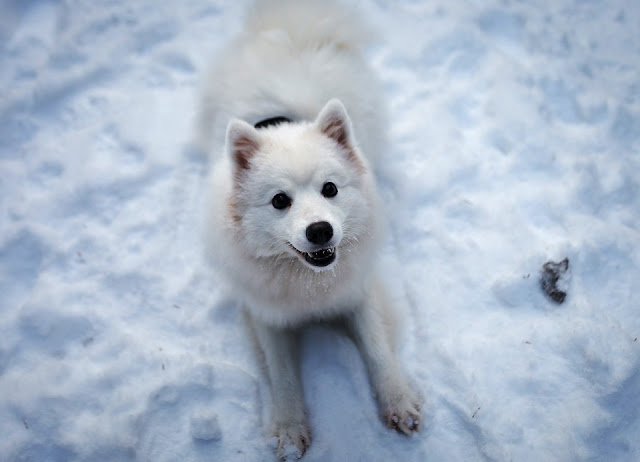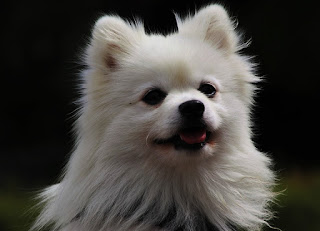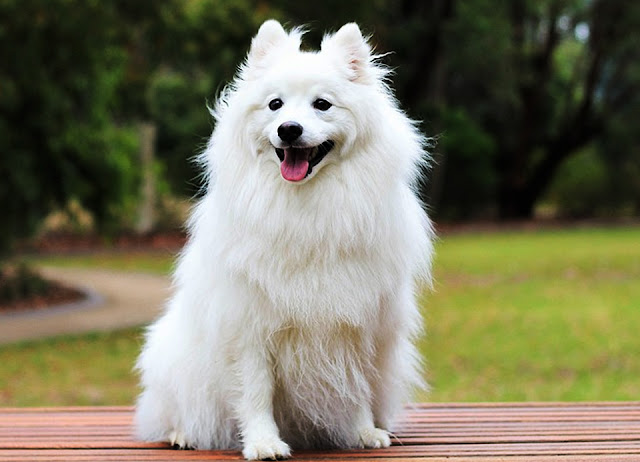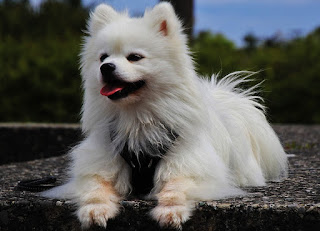Spitz Article Contents The Dwarf Spitz: small but strong Appearance of the Pomeranian laulau: a featherweight with an abundant coat. Miniatu...
Spitz Article Contents
- The Dwarf Spitz: small but strong
- Appearance of the Pomeranian laulau: a featherweight with an abundant coat.
- Miniature version of the Spitz
- Character of the Pomeranian dog: a dog with a cheerful nature
- Education of the Dwarf Spitz
- A mini model with multiple passions
- Small but refined meals!
- Care of the Spitz: a dwarf with a lion's coat
- Is the Dwarf Spitz right for me?
- Where to adopt a Miniature Spitz?
The Dwarf Spitz: small but strong
The Miniature Spitz, also known as the Pomeranian Spitz or Pomeranian Dog, is a miniature dog breed that originated in the province of Pomerania, a territory now straddling Germany and Poland. If it is not by its size that the Miniature Spitz impresses, it is undoubtedly by its friendly character, self-confidence and energy. No wonder that more and more Miniature Spitz dogs are winning the hearts of animal lovers!
Appearance of the Pomeranian Sheepdog: a featherweight with an abundant coat
With a height at the withers of between 18 and 22 cm, the Dwarf Spitz really lives up to its name. A real Spitz in miniature size! On the scales he weighs no more than 3.5 kg, which makes him lighter than most cats. His dense and voluminous coat, due to his thick undercoat, gives his body swelling. Sometimes his coat may even look spiky. It can be white, sand, black, cream or have several different shades. The lion's mane-like collar surrounds his head. The wide-open eyes of the Pomeranian dog and his foxlike muzzle give him an alert, ever attentive look.
Miniature variant of the Spitz
The Miniature Spitz cannot be considered as a dog breed in its own right, since it is strictly speaking a miniature variant of the German Spitz. While the Spitz belongs to the oldest dog breeds, breeding of the Dwarf Spitz has intensified in recent decades.
Since the first small Spitz puppies were bred in the German province of Pomeron, the breed is called Laulau de Pomerania or Pomeranian dog in French, and Pomeranian in English. After the efforts made by Great Britain to breed this breed, more and more Miniature Spitz breeders were set up in Germany, the country of origin of the breed. But the breeding of these little furry balls has attracted much criticism, because very small Spitz are prone to disease, at least more than their larger and more robust cousins. Dwarf Spitz are particularly popular in the United States and Great Britain, known as the "King of Toys".
Character of the Pomeranian dog: a dog with a cheerful nature
The Dwarf Spitz is small, a detail that seems to have escaped him. Generally speaking, Dwarf Spitz's are characterized by their great self-confidence and occasionally by their arrogance. And this even sometimes towards significantly larger dogs! On the other hand, Miniature Spitz are attentive, friendly towards humans and animals and not at all aggressive. He can live quite well in the company of several other dogs, but will not give up the fact of following his master everywhere, which he is particularly fond of.
The good humor of the Miniature Spitz is communicative, to the delight of those around him. He is also always ready for a game. He barks as soon as a stranger approaches his territory. In this case, the sound volume is surprisingly high, considering its small size! The Spitz can express its joy by barking, or bark as a greeting as soon as it meets people it is familiar with. On the contrary, the Dwarf Spitz shows no hunting instincts.
Education of the Dwarf Spitz
Teach your Dwarf Spitz to stay alone at an early age. If they are not confronted with this learning at a relatively early age, it will be even more difficult to make adult Miniature Spitz's understand that they can stay home alone. However, don't leave your Miniature Spitz alone for more than a little while, as these moments of loneliness are relatively painful for him.
From an early age, get your Miniature Spitz used to being around other pets and other dogs. To do this, why not visit a dog club near you to take a few training courses or participate in a few play sessions with other puppies. The more you counter the confident character of your Miniature Spitz towards his fellow dogs, the better! To achieve this, you will need to work on socializing your dog and bringing him into contact with other four-legged friends. The Pomeranian Spitz is a dog that learns quickly and willingly.
A mini model with multiple passions
In spite of its small size, the Dwarf Spitz appreciates walks at a moderate pace just as much as short walks in the neighborhood, even on rainy days. Anything but a lazy dog in short! Its size is very advantageous when you have to carry it on stairs or public transport, for example. Miniature Spitz love to learn new tricks and be congratulated for their success. The majority of Spitz and master duos take great pleasure in training with the Clicker. Ball games or even agility bring great joy to the Miniature Spitz, provided that the agility obstacles provided are suitable for his size. Try out different activities with your companion to find out which ones he prefers. And don't forget to vary the fun! After specific training, Pomeranian dogs can also act as therapy dogs.
Small but refined meals!
These graceful little dogs must avoid being overweight at all costs! A Miniature Spitz consumes small amounts of food every day, but it should be of good quality! When choosing your hairball's food - whether it's wet canned food or kibble - make sure to take a look at the meat content. Meat should be at the top of the ingredient list. It is advisable to cross out cereal-rich foods.
To ensure that your dog can enjoy the benefits of both types of food, you can alternate between cans and kibbles. Often, dog cans and pouches are more successful: they are richer in water, contain fewer calories and the volume of food in the bowl is greater. If you feed your Miniature Spitz, make sure that it consumes enough water. Choose kibbles developed for small breeds, so that the size of the kibble is adapted to the fangs of the Pomeranian dog. The daily rations indicated by the manufacturer can be used as a basis. Dogs as light as the Miniature Spitz feed on very small portions, which many owners tend to forget. And with good reason, overweight should absolutely be avoided!
After feeding, always allow your dog to enjoy a quiet moment or a short nap. Feeding your dog once or twice a day is more than enough. Be careful not to spoil your dog with too many treats and keep in mind that a weight gain of 500 grams corresponds to 10% of the total weight of a Miniature Spitz.
Care of the Spitz: a dwarf with a lion's coat
Because of its abundant coat, the Pomeranian Sheepdog must be brushed regularly. For example, plan for two weekly brushing sessions, during which you thoroughly brush your Spitz, also with the back hair. To clean the eyes and ears of your Miniature Spitz, turn to specific gentle products. Some owners brush their dog's teeth with a toothbrush and a dog toothpaste. By getting your puppy used to this, you can effectively prevent the formation of tartar. If you find this too much of a hassle, you can always turn to dog treats and chews for small dogs that take care of their teeth.
Furthermore, the little hairballs of the Miniature Spitz are not very tolerant of extreme heat. In summer, make sure your dog always has a small place in the shade and walk him/her during the cooler hours of the day. Despite their fragility, Miniature Spitz can reach an age of 12 to 16 years.
Spitz diseases
Extreme physical characteristics leave people vulnerable to certain diseases. The Spitz, more fragile than its larger cousins in size, is no exception. It tends to suffer from misaligned kneecaps, respiratory problems due to tracheal collapse and heart disease. That's why it's especially important to adopt your Miniature Spitz puppy from a breeder you trust and who takes great care of his animals' health.
Is the Dwarf Spitz right for me?
These affectionate companions like to be at their master's side at all times. That's why you should never leave your Dwarf Spitz alone for too long. The dynamic, playful Spitz, who is playful but does not enjoy long walks, can share the life of elderly or active people who want to take their dog to the office.
Families with children should always make sure that their Spitz has a quiet place of its own and the possibility to retreat in all situations. If he feels trapped in a corner, he might bite! It will therefore be safer to adopt a Miniature Spitz if your children are not very young. Your children will be able to play with it while taking its small size into consideration and teach it a few tricks.
People who do not have much experience with dogs can live in harmony with a Miniature Spitz, provided they have not underestimated the care and play time to dedicate to their companion. These cheerful natured companions can absolutely live in the city, as they get used to all environments very quickly. As long as they spend a lot of time with their master, of course!
The Dwarf Spitz proves to be a perfect travelling companion. But because of its strong attachment, don't leave it in the hands of strangers. Because of its size, you can take it everywhere, very easily. In a transport cage, it accompanies you to the cabin.
Before buying a Pomeranian Laulau, remember that from the moment he arrives, you are committed to taking care of your dog on a daily basis, satisfying his play needs and taking care of his coat. You will need to purchase essential dog accessories such as dog bowls, collar, harness, leash, toys, a blanket or basket, grooming supplies and safety accessories for transporting your dog in the car. Veterinary check-ups and vaccinations also incur costs. In the event of illness, these costs can quickly disappear.
Where to adopt a Miniature Spitz?
If you have fallen in love with this breed, look for a breeder who belongs to a breeding association. This is a very important criterion, as this variant of the Spitz can be affected by genetic diseases. The best prevention is to go to serious breeders, who breed their dwarf Spitz with full knowledge of the facts and who carry out frequent health analyses and tests. This way they ensure that their breeding is only made up of healthy Dwarf Spritzes.
You have contacted a breeder and are interested in one of his puppies? You will normally have the opportunity to visit the kennel to see the little protégé. This is the ideal time to ask all your questions about the Spitz breed! The breeder will be happy to answer your questions, help you in your quest and give you more details about the Spitz. Once there, observe the parents of the puppies, they should appear balanced and healthy to you.
In general, you will be able to welcome your Pomeranian Spitz as soon as possible after its eight weeks of age. At the time of adoption, you leave with your puppy equipped with a microchip, dewormed and you will be given his identity papers, his pedigree and a vaccination booklet. Don't forget to respect the deadlines for booster vaccinations!
If you wish to adopt an older Miniature Spitz, you can do some research on the internet. Friendly dogs of the breed are waiting for a new home! In addition to Dwarf Spitz breeders and breeders' associations, there are a number of associations that can help you in your search!





No comments